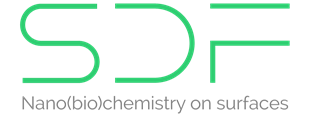Molecular switches on surfaces - a collaboration with the Feringa team

Immobilization of stimulus-responsive systems on solid surfaces is beneficial for controlled signal transmission and adaptive behavior while allowing the characterization of the functional interface with high sensitivity and high spatial resolution. Positioning of the stimuli-responsive units with nanometer-scale precision across the adaptive surface remains one of the bottlenecks in the extraction of cooperative function. Nanoscale organization, cooperativity, and amplification remain key challenges in bridging the molecular and the macroscopic worlds. Here we report on the design, synthesis, and scanning tunneling microscopy (STM) characterization of overcrowded alkene photoswitches merged in self-assembled networks physisorbed at the solid-liquid interface. A detailed anchoring strategy that ensures appropriate orientation of the switches with respect to the solid surface through the use of bis-urea groups is presented. We implement a co-assembly strategy that enables the merging of the photoswitches within physisorbed monolayers of structurally similar ‘spacer’ molecules. The selfassembly of the individual components and the co-assemblies was examined in detail using (sub)molecular resolution STM which confirms the robust immobilization and controlled orientation of the photoswitches within the spacer monolayers. The experimental STM data is supported by detailed molecular mechanics (MM) simulations. Different designs of the switches and the spacers were investigated which allowed us to formulate guidelines that enable the precise organization of the photoswitches in crystalline physisorbed self-assembled molecular networks.
Read the full story in Chem.Eur.J.
To enable comments sign up for a Disqus account and enter your Disqus shortname in the Articulate node settings.


